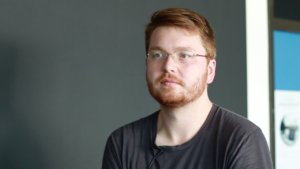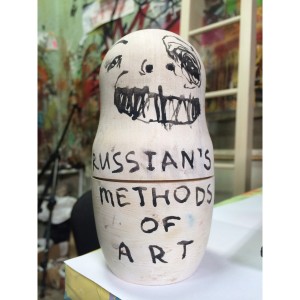When I’m working with a patent, there will be a – there’s like the intellectual property I consider a material in itself, which is this kind of like intangible, mostly intangible thing, that’s basically just a legal agreement. And then there’s maybe the, the drawings or schematics or like Photoshop documents or Rhino documents that I make to get to the point I’ll then produce the object or this[?] governed by the intellectual property and then with the Image Objects for example it’s kind of – it works in a very similar way, the, like the digital file I consider very much over all a part of the work. I think that I am interested in the moments where you do translate immaterial to material and maybe back again. At the same time, I do feel like overall, it’s all kind of like part of the same system, if that makes sense. The, you know, there are like – there are files for example, there are works that existed as files that I’ve never made that – were never like physically produced, I guess, because they haven’t been made. That I feel like, we’re very much on an equal footing with the objects that I’ve finally actually produced but it’s, you know, it’s when like, I think in a way it’s just a, it’s another method of representing or kind of instantiating the work. In the same way that, you know, which is why the documentation of the work itself is also such a critical part of it, basically, because it’s about acknowledging all of these separate parts and ironically, it’s kind of like at the beginning of the process at least as it like unfolds in time. It starts with this digital file which point it’s not – it doesn’t have that, like, scarcity of, you know, the like, the very the reality that only so many things can be produced or sensibly produced or whatever and then it passes into this mode where it kind of becomes scarce for a period it is printed in, becomes an object. And then when it’s photographed, that photograph, because I go back into it and edit it and change it and that varies like layers of abstraction. Those – like it becomes not scarce again, basically. It’s, you know, for the most part, one photo of an Image Object will be, will be very much the same photo but, like, the different – like in working back into it, the different instantiations of that mechanics like makes it again not scarce. Which, I think, is just kind of like just trying to be true to the nature, which, I think, is just trying to be true to the nature of the medium, basically. I think that when I was first starting to work this way, for example, I kind of understood that I wanted to make every stage of it like make sense for what that medium’s nature was, I suppose. So, images and documentation can like circulate freely and be kind of infinitely variable, if you want it to, whereas the moment that you print something or produce something it becomes this like cold dead matter that you can change but in order to change it you have to ontologically destroy it or something. You destroy what was and you have to turn it into something else. So, actually in a way, the things that are the physical objects, for a lack of a better word, are the document, more so than the documentation, I suppose.

















